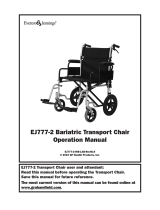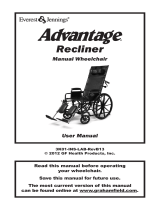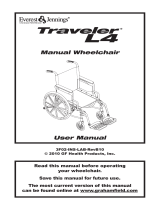
3J01-INS-LAB-RevB13•TravelerHTCUserManual 11
RAMPSANDINCLINES
WARNING: During descent, the footplates' lowest point should
be no closer to the ground than 2
1
/2 inches to permit proper
clearance.
WARNING: Do not attempt inclines without anti-tippers installed
in the downward position. Do not attempt any incline or decline
of more than 6 degrees (10% grade, or one foot of rise or fall
per ten feet of ramp length).
WARNING: Do not use wheel locks to slow your descent.
Attempting to use wheel locks is likely to result in accidental
locking that could cause the wheelchair to stop abruptly,
suddenly pitch forward, or tip sideways.
WARNING: Avoid changing direction while descending a ramp or
incline, as this could cause instability.
Most people are capable of negotiating short inclines without assistance,
depending upon upper body strength, endurance, and the degree of
incline. Know your own capabilities and limitations in terms of strength
and endurance before attempting to negotiate an incline or decline.
Practice with an attendant or healthcare professional first before
attempting any inclines, declines, curbs or ramps. Always inspect the
ramp for hazards such as holes, slippery or uneven surfaces, etc. before
starting up or down. If you can not see the entire ramp, ask someone to
inspect it for you.
Ascent
Lean the upper part of your body slightly forward as you ascend the
incline. If it becomes necessary to stop on the incline, avoid any abrupt
or sudden forward movement as you resume climbing, this could cause
tipping.
Descent
Always face forward when going down a ramp, but do not lean forward;
this could cause tipping. Lean slightly backward to increase stability. It is
critical to keep the wheelchair under control at all times. Descent should
be made slowly and safely by grasping the handrims; however, use care,
as friction heat will be generated. We recommend the use of gloves to
reduce the effects of friction heat, but going slower is a better alternative.

























